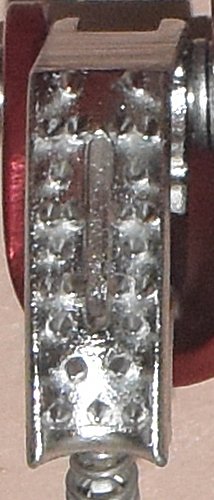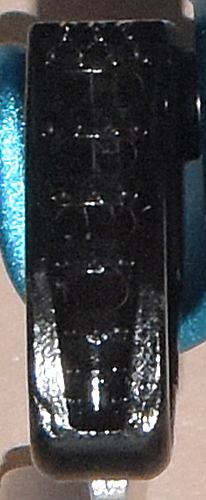Overview
[ Top
| Version B
| Return to E.C. Ascenders
]
Version A
(#3428)
Technical Details
 I acquired my NewDoar, Version A from FSAS LLC in 2021.
I acquired my NewDoar, Version A from FSAS LLC in 2021.
Version A is 111 mm. tall, 74 mm. wide, 35 mm. thick, and weighs 138 g. The ascender shell is subtriangular
shape bent from 3.9 mm. aluminum sheet. The
rope channel is formed by bending the right side of the ascender
into a U. The rope channel is 16 mm. wide. The main sling attachment point is located below the cam and behind the
rope channel. A second attachment point is located above the cam,
also behind the rope channel. The shell is bent backwards at both
points to provide clearance between the attachment slings and
the main rope. This accounts for the rather large thickness of
this ascender. The attachment points are pear-shaped openings distorted
by the stamping operation. The lower attachment point measures
24.9 by 22.5 mm. and the upper 26.1 by 19.7 mm. The left side
of the shell is bent on an inclined axis to form another U. A
hole drilled through both sides of the U accepts a semi-tubular rivet.
The cam and cam spring are mounted on this rivet. The pivot is centered 48 mm. from the inside of the rope channel.
The cam is a stainless steel casting with a hybrid form consising of a large opening behind the mud slot, a smaller oepning behind this, and a reinforced partial web filling the remainder. The cam radius increases from 36 to 52 mm. over an angle of 38°, giving a 30° cam angle. The cam has number of small conical sloping teeth. The tooth pattern is (2.4)(1S1.2S2)^2(1S1)(2.3) where the "S" represents a single longitudinal mud slot. Like many other ascenders, the inner cam face radius reduces from top to bottom to accommodate various sized ropes.
A spring-loaded manual safety tab is attached to the cam with a semi-tubular rivet. The safety is stamped from 2.5 mm. aluminum alloy. The lower portion is bent outward about 60° to form a thumb tab. The top of the tab has a stamped checkered pattern. The spring is a compression spring that fits over a post on the base of the cam and a small tab on the stamped safety. The normal action of the spring holds the safety against the cam. When the cam is opened, the shell interferes with the safety, thus preventing opening the cam. If the safety is moved away from the cam (opposing the spring), it will clear the shell and the cam will open. At full open the safety can be released and the spring will hold the safety against the back of the shell. This provides a means of locking the cam open.
The front of the rope channel is printed with an up-pointing arrow, "UP," "MAX 4kN," the NewDoar logo, and "ROPE Ø8<Ø<13mm." The rear is printed with the NewDoar logo, "CE1019," "EN 567:2013," a book-with-an-"i" icon, "0820," and a small mystery icon.
I feel that this is a well made ascender. All sharp edges have been removed. The cam teeth are rather well done.
The tab on the safety is rather small and slopes downward, allowing one’s thumb to slip off rather easily.
Version A is essentially identical to the Goracon and the Proverti 202L.
[ Top
| Version A
| Return to E.C. Ascenders
]
Version B
(#3427)
Technical Details
I acquired my NewDoar, Version B from Meituo on Amazon.com in 2021.
 Version B is 116 mm. tall, 78 mm. wide, 31 mm. thick, and weighs 160 g. The ascender shell is a subtriangular
orange anodized aluminum stamping 3.75 mm. thick. The rope
channel is formed by bending the right side of the ascender into
a U. The rope channel is 16 mm. wide. The main sling attachment point is located
below the cam and behind the rope channel. A second attachment
point is located above the cam and also behind the rope channel.
The shell is bent backwards at both points to provide clearance
between the attachment slings and the main rope. This accounts
for the rather large thickness of this ascender. The lower attachment point measures 27.2 by 19.0 mm.
and the upper 23.8 by 17.3 mm. The left end of the shell is
bent on an inclined axis to form another U. A hole drilled through
both sides of the U accepts a semi-tubular rivet. The cam, cam spring,
and a spacer washer are mounted on this rivet. The head of the
rivet sits into a stamped depression on the back of the cam, while
the roll is exposed on the open side. The pivot is centered 42 mm.
from the inside of the rope channel. There is a cam stop punched in the shell above the cam, but it is placed where it does not touch the cam when the ascender is off rope.
Version B is 116 mm. tall, 78 mm. wide, 31 mm. thick, and weighs 160 g. The ascender shell is a subtriangular
orange anodized aluminum stamping 3.75 mm. thick. The rope
channel is formed by bending the right side of the ascender into
a U. The rope channel is 16 mm. wide. The main sling attachment point is located
below the cam and behind the rope channel. A second attachment
point is located above the cam and also behind the rope channel.
The shell is bent backwards at both points to provide clearance
between the attachment slings and the main rope. This accounts
for the rather large thickness of this ascender. The lower attachment point measures 27.2 by 19.0 mm.
and the upper 23.8 by 17.3 mm. The left end of the shell is
bent on an inclined axis to form another U. A hole drilled through
both sides of the U accepts a semi-tubular rivet. The cam, cam spring,
and a spacer washer are mounted on this rivet. The head of the
rivet sits into a stamped depression on the back of the cam, while
the roll is exposed on the open side. The pivot is centered 42 mm.
from the inside of the rope channel. There is a cam stop punched in the shell above the cam, but it is placed where it does not touch the cam when the ascender is off rope.
The cam is a skeletonized casting covered with black paint. The cam radius increases from 37 to 57 mm. over an angle of 40°, giving a 31° cam angle. The cam has number of small conical teeth, all
of which have their axes sloping slightly downward with respect to the cam face. The tooth pattern is (3)(4.H)^2(3.H)^2(3.2.2) where an "H" represents a mud relief hole. A spring-loaded
manual safety bar is mounted on the bottom of the cam. The normal action of the spring holds
the safety against the cam. When the cam is opened, the shell
interferes with the safety bar, thus preventing opening the cam.
If the safety bar is moved away from the cam (opposing the spring),
it will clear the shell and the cam will open. At full open the
safety can be released and the spring will hold the safety against
the back of the shell. This provides a means of locking the cam
open. A bent tab on the safety bar assists in operating
the safety mechanism.
The front of the rope channel is printed with an up-pointing arrow, "UP," "MAX 4kN," "CE1019," "EN 567," and "ROPE Ø8<Ø<13mm." The rear is printed with the NewDoar logo and "1220."
I feel that this is a well made ascender. All sharp
edges have been removed.
The cam teeth are rather well done, though
not quite as well as some of my older Petzl’s. I don't like the black paint on the cam.
The cam safety is heavier than the one on Version A. It does not slope downward like the Version A safety, so it is easier to use.
The cam stop is useless in practice; its only role is to inflate the strength of the ascender in the artificial tests prescribed by various standards.
Version B is essentially identical to the SUT.
[ Top
| Version A
| Version B
]


